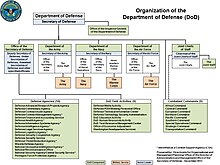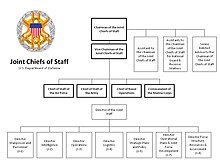United States Department of Defense
| Child agencies | |
|---|---|
| Website | defense.gov |
| United States Armed Forces |
|---|
 |
| Executive departments |
| Staff |
| Military departments |
| Military services |
| Command structure |
The United States Department of Defense (DoD,[2] USDOD, or DOD) is an executive branch department of the federal government of the United States charged with coordinating and supervising all agencies and functions of the U.S. government directly related to national security and the United States Armed Forces. As of June 2022, the U.S. Department of Defense is the largest employer in the world,[3] with over 1.34 million active-duty service members, including soldiers, marines, sailors, airmen, and guardians. The Department of Defense also maintains over 778,000 National Guard and reservists, and over 747,000 civilians bringing the total to over 2.87 million employees.[4] Headquartered at the Pentagon in Arlington County, Virginia, just outside Washington, D.C., the Department of Defense's stated mission is to provide "the military forces needed to deter war and ensure our nation's security".[5][6]
The Department of Defense is headed by the
History
Faced with rising tensions between the Thirteen Colonies and the British government, one of the first actions taken by the First Continental Congress in September 1774 was to recommend that the colonies begin defensive military preparations. In mid-June 1775, after the outbreak of the Revolutionary War, the Second Continental Congress, recognizing the necessity of having a national army that could move about and fight beyond the boundaries of any particular colony, organized the Continental Army on June 14, 1775.[7][8] This momentous event is commemorated in the U.S. annually as Flag Day. Later that year, Congress would charter the Continental Navy on October 13,[9] and the Continental Marines on November 10.
Upon the seating of the
National Military Establishment
After the end of
On July 26, 1947, Truman signed the
Under the
Financial discrepancies
Organizational structure


The Secretary of Defense, appointed by the president with the advice and consent of the Senate, is by federal law (10 U.S.C. § 113) the head of the Department of Defense, "the principal assistant to the President in all matters relating to Department of Defense", and has "authority, direction, and control over the Department of Defense". Because the Constitution vests all military authority in Congress and the president, the statutory authority of the secretary of defense is derived from their constitutional authority. Since it is impractical for either Congress or the president to participate in every piece of Department of Defense affairs, the secretary of defense and the secretary's subordinate officials generally exercise military authority.
The Department of Defense is composed of the Office of the Secretary of Defense (
Department of Defense Directive 5100.01 describes the organizational relationships within the department and is the foundational issuance for delineating the major functions of the department. The latest version, signed by former secretary of defense Robert Gates in December 2010, is the first major re-write since 1987.[21][22]
Office of the Secretary of Defense

The Office of the Secretary of Defense (OSD) is the secretary and their deputies, including predominantly civilian staff. OSD is the principal staff element of the Secretary of Defense in the exercise of policy development, planning, resource management, fiscal and program evaluation and oversight, and interface and exchange with other U.S. federal government departments and agencies, foreign governments, and international organizations, through formal and informal processes. OSD also performs oversight and management of the Defense Agencies, Department of Defense Field Activities, and specialized Cross Functional Teams.
Defense agencies
OSD is a parent agency of the following defense agencies:
- Armed Forces Radiobiology Research Institute (AFRRI)
- Department of Defense Education Activity (DoDEA)
- Defense Advanced Research Projects Agency(DARPA)
- Defense Commissary Agency (DeCA)
- Defense Contract Audit Agency (DCAA)
- Defense Contract Management Agency (DCMA)
- Defense Finance and Accounting Service (DFAS)
- Defense Health Agency (DHA)
- Defense Information Systems Agency (DISA)
- Defense Legal Services Agency
- Defense Logistics Agency (DLA)
- Defense POW/MIA Accounting Agency (DPAA)
- Defense Security Cooperation Agency (DSCA)
- Defense Counterintelligence and Security Agency (DCSA)
- Defense Technical Information Center (DTIC)
- Defense Threat Reduction Agency (DTRA)
- Space Development Agency (SDA)
National intelligence agencies
Several defense agencies are members of the United States Intelligence Community. These are national-level intelligence services that operate under the Department of Defense jurisdiction but simultaneously fall under the authorities of the Office of the Director of National Intelligence. They fulfill the requirements of national policymakers and war planners, serve as Combat Support Agencies, and also assist non-Department of Defense intelligence or law enforcement services such as the Central Intelligence Agency and the Federal Bureau of Investigation.
The military services each have their own intelligence elements that are distinct from but subject to coordination by national intelligence agencies under the Department of Defense. Department of Defense manages the nation's coordinating authorities and assets in disciplines of
- National Intelligence Agencies under the Department of Defense
Joint Chiefs of Staff

The
Following the
The Joint Staff (JS) is a headquarters staff at the
Military departments and services
There are three military departments within the Department of Defense:
- the Department of the Army, within which the United States Army is organized.
- the Department of the Navy, within which the United States Navy and the United States Marine Corps are organized.
- the Department of the Air Force, within which the United States Air Force and United States Space Force are organized.
The Military Departments are each headed by their own secretary (i.e., Secretary of the Army, Secretary of the Navy and Secretary of the Air Force), appointed by the president, with the advice and consent of the Senate. They have the legal authority under Title 10 of the United States Code to conduct all the affairs of their respective departments within which the military services are organized.[34] The secretaries of the Military Departments are (by law) subordinate to the secretary of defense and (by SecDef delegation) to the deputy secretary of defense.
Secretaries of military departments, in turn, normally exercise authority over their forces by delegation through their respective service chiefs (i.e.,
Secretaries of Military Departments and service chiefs do not possess operational command authority over U.S. troops (this power was stripped from them in the
- Military Departments of the Department of Defense
- Military Services of the Department of Defense
Unified Combatant Commands

A unified combatant command is a military command composed of personnel/equipment from at least two Military Departments, which has a broad/continuing mission.[36][37]
These military departments are responsible for equipping and training troops to fight, while the Unified Combatant Commands are responsible for military forces' actual operational command.
During military operations, the chain of command runs from the president to the
As of 2019[update], the United States has eleven Combatant Commands, organized either on a geographical basis (known as "area of responsibility", AOR) or on a global, functional basis:[38]
- U.S. Northern Command(USNORTHCOM)
- U.S. Southern Command(USSOUTHCOM)
- U.S. Central Command(USCENTCOM)
- U.S. European Command(USEUCOM)
- U.S. Indo-Pacific Command(USINDOPACOM)
- U.S. Africa Command(USAFRICOM)
- U.S. Strategic Command(USSTRATCOM)
- U.S. Special Operations Command(USSOCOM)
- U.S. Transportation Command(USTRANSCOM)
- U.S. Cyber Command(USCYBERCOM)
- U.S. Space Command(USSPACECOM)
Budget
This section needs to be updated. (April 2019) |


Department of Defense spending in 2017 was 3.15% of GDP and accounted for about 38% of budgeted
The Department of Defense accounts for the majority of federal discretionary spending. In FY 2017, the Department of Defense budgeted spending accounted for 15% of the U.S. federal budget, and 49% of federal discretionary spending, which represents funds not accounted for by pre-existing obligations. However, this does not include many military-related items that are outside the Defense Department budget, such as nuclear weapons research, maintenance, cleanup, and production, which is in the Department of Energy budget, Veterans Affairs, the Treasury Department's payments in pensions to military retirees and widows and their families, interest on debt incurred in past wars, or State Department financing of foreign arms sales and militarily-related development assistance. Neither does it include defense spending that is not military in nature, such as the Department of Homeland Security, counter-terrorism spending by the FBI, and intelligence-gathering spending by the NSA.
In the
In 2015 the allocation for the Department of Defense was $585 billion,[46] the highest level of budgetary resources among all Federal agencies, and this amounts to more than one-half of the annual Federal Expenditures in the United States federal budget discretionary budget.[47]
On September 28, 2018, President Donald Trump signed the Department of Defense and Labor, Health and Human Services, and Education Appropriations Act, 2019 and Continuing Appropriations Act, 2019 (H.R.6157) into law.[48] On September 30, 2018, the FY2018 Budget expired and the FY2019 budget came into effect.
FY2019
The FY2019 Budget for the Department of Defense is approximately $686,074,048,000[49] (Including Base + Overseas Contingency Operations + Emergency Funds) in discretionary spending and $8,992,000,000 in mandatory spending totaling $695,066,000,000
The Department of Defense budget encompasses the majority of the National Defense Budget of approximately $716.0 billion in discretionary spending and $10.8 billion in mandatory spending for a $726.8 billion total. Of the total, $708.1 billion falls under the jurisdiction of the House Committee on Armed Services and Senate Armed Services Committee and is subject to authorization by the annual National Defense Authorization Act (NDAA). The remaining $7.9 billion falls under the jurisdiction of other congressional committees.[51]
The Department of Defense is unique because it is one of the few federal entities where the majority of its funding falls into the discretionary category. The majority of the entire federal budget is mandatory, and much of the discretionary funding in the budget consists of DoD dollars.
Budget overview
| Title | FY 2019 ($ in thousand)* |
|---|---|
| Military Personnel | $152,883,052 |
| Operation and Maintenance | $283,544,068 |
| Procurement | $144,340,905 |
| RDT&E | $92,364,681 |
| Revolving and Management Funds | $1,557,305 |
| Defense Bill | $674,690,011 |
| Military Construction | $9,801,405 |
| Family Housing | $1,582,632 |
| Military Construction Bill | $11,384,037 |
| Total | $686,074,048 |
* Numbers may not add due to rounding
Criticism
A 2013 Reuters investigation concluded that Defense Finance & Accounting Service, the Department of Defense's primary financial management arm, implements monthly "unsubstantiated change actions"—illegal, inaccurate "plugs"—that forcibly make DoD's books match Treasury's books.[53] It concluded:
Fudging the accounts with false entries is standard operating procedure... Reuters has found that the Pentagon is largely incapable of keeping track of its vast stores of weapons, ammunition, and other supplies; thus it continues to spend money on new supplies it doesn't need and on storing others long out of date. It has amassed a backlog of more than half a trillion dollars... [H]ow much of that money paid for actual goods and services delivered isn't known.[54]
In 2015, a Pentagon consulting firm performed an audit on the Department of Defense's budget. It found that there was $125 billion in wasteful spending that could be saved over the next five years without layoffs or reduction in military personnel. In 2016, The Washington Post uncovered that rather than taking the advice of the auditing firm, senior defense officials suppressed and hid the report from the public to avoid political scrutiny.[55] The Department of Defense failed its fifth audit in 2022, and couldn't account for more than 60% of its $3.5 trillion in assets.[56]
In the latest Center for Effective Government analysis of 15 federal agencies which receive the most Freedom of Information Act requests, published in 2015 (using 2012 and 2013 data, the most recent years available), the DoD earned 61 out of a possible 100 points, a D− grade. While it had improved from a failing grade in 2013, it still had low scores in processing requests (55%) and their disclosure rules (42%).[57]
Shortly after the
Related legislation
The organization and functions of the Department of Defense are in Title 10 of the United States Code.
Other significant legislation related to the Department of Defense includes:
- 1947: National Security Act of 1947
- 1958: Department of Defense Reorganization Act, Pub. L. 85–599
- 1963: Pub. L. 88–149
- 1963: Military Construction Authorization Act, Pub. L. 88–174
- 1967: Pub. L. 90–8
- 1984: Department of Defense Authorization Act, Pub. L. 98–525
- 1986: Pub. L. 99–433
- 1996: Pub. L. 104–132 (text) (PDF)
See also
- Arms industry
- Energy usage of the United States military
- List of United States defense contractors
- List of United States military bases
- Military–industrial complex
- Nuclear weapons
- Private military company
- Title 32 of the Code of Federal Regulations
- United States Department of Homeland Security
- United States Department of Justice
- United States Department of Veterans Affairs
- Warrior Games
- JADE (planning system)
- Global Command and Control System
References
- ^ "DoD Personnel, Workforce Reports & Publications". Defense Manpower Data Center. June 30, 2022. Archived from the original on November 3, 2022. Retrieved October 30, 2022.
- ^ "Manual for Written Material" (PDF). Department of Defense. p. 9. Archived from the original (PDF) on August 29, 2004. Retrieved December 10, 2014.
- ^ "The World's Biggest Employers". Forbes. Archived from the original on June 26, 2015. Retrieved July 31, 2015.
- ^ "DoD Personnel, Workforce Reports & Publications". www.dmdc.osd.mil. Archived from the original on November 3, 2022. Retrieved October 30, 2022.
- ^ "U.S. DEPARTMENT OF DEFENSE > Our Story". www.defense.gov. Archived from the original on October 7, 2018. Retrieved October 17, 2018.
- ^ Szoldra, Paul (June 29, 2018). "Trump's Pentagon Quietly Made a Change to the Stated Mission It's Had for Two Decades". Task & Purpose. Archived from the original on June 30, 2018. Retrieved July 1, 2018.
- ISBN 978-1451623536.
- ^ Maass, John R. (June 14, 2012). "June 14th: The Birthday of the U.S. Army". U.S. Army Center of Military History. Archived from the original on October 1, 2018. Retrieved June 19, 2014.
- ^ "Congress Officially Created the U.S. Military: September 29, 1789". Library of Congress. Archived from the original on October 3, 2014. Retrieved June 20, 2014.
- ^ Joe Carmel, ed. (n.d.) [Original Statute 1789]. "Statutes at Large, Session I, Charter XXV" (PDF). Legisworks. Archived from the original (PDF) on May 25, 2017. Retrieved January 28, 2018.
An Act to recognize and adapt to the Constitution of the United States the establishment of the Troops raised under the Resolves of the United States in Congress assembled, and for other purposes therein mentioned.
- ISBN 978-0-521-79537-1.
- ISBN 978-1-59114-685-8.
- ^ a b "James V. Forrestal, Harry S. Truman Administration". Historical Office, Office of the Secretary of Defense. Office of the Secretary of Defense. Archived from the original on August 14, 2017. Retrieved July 25, 2017.
- ISBN 978-0-7425-5900-4.
- ISBN 978-0-684-80657-0.
- ^ "National Archives NextGen Catalog". catalog.archives.gov. Archived from the original on November 13, 2022. Retrieved November 30, 2022.
- ^ "The Unified Combatant Command System". www.usmcu.edu. January 7, 2022. Retrieved July 20, 2023.
- ^ Paltrow, Scot J.; Carr, Kelly (July 2, 2013). "Reuters Investigates - Unaccountable: The Pentagon's bad bookkeeping". Reuters. Archived from the original on January 6, 2020. Retrieved December 24, 2019.
- ^ Paltrow, Scot J. (August 19, 2016). "U.S. Army fudged its accounts by trillions of dollars, auditor finds". Reuters. Archived from the original on December 21, 2017. Retrieved December 18, 2017.
- ^ "Organizational and Management Planning". Odam.defense.gov. Archived from the original on May 7, 2013. Retrieved June 15, 2013.
- ^ "Directives Division" (PDF). www.dtic.mil. Archived from the original (PDF) on May 25, 2017. Retrieved May 3, 2012.
- ^ [1] 10 USC 151. Joint Chiefs of Staff: composition; functions
- ^ 10 U.S.C. § 3033 Archived March 12, 2013, at the Wayback Machine
- ^ 10 U.S.C. § 5033 Archived March 12, 2013, at the Wayback Machine
- ^ 10 U.S.C. § 5043 Archived March 12, 2013, at the Wayback Machine
- ^ 10 U.S.C. § 8033 Archived March 12, 2013, at the Wayback Machine
- ^ "10 U.S. Code § 151(b)(1) - Joint Chiefs of Staff: composition; functions". LII / Legal Information Institute. Retrieved July 20, 2023.
- ^ "10 U.S. Code § 151 - Joint Chiefs of Staff: composition; functions". LII / Legal Information Institute. Retrieved July 20, 2023.
- ^ 10 U.S.C. § 162(b) Archived May 29, 2013, at the Wayback Machine
- ^ 10 U.S.C § 151(b) Archived March 12, 2013, at the Wayback Machine
- ^ 10 U.S.C § 155 Archived March 12, 2013, at the Wayback Machine
- ISBN 978-1-59114-685-8.
- ^ 10 U.S.C. § 3013, 10 U.S.C. § 5013 and 10 U.S.C. § 8013
- ^ ISBN 978-1-59114-685-8.
- ISBN 978-0-313-35432-8.
- ^ ISBN 978-1-60442-462-1.
- ^ "Combat Commands". US Department of Defense. Archived from the original on January 17, 2020. Retrieved January 14, 2020.
- ^ "Military expenditure (% of GDP). Stockholm International Peace Research Institute ( SIPRI ), Yearbook: Armaments, Disarmament, and International Security". World Bank. Archived from the original on April 25, 2010. Retrieved March 8, 2019.
- ^ a b "Paul McLeary (February 05, 2020) SecDef Eyeing Moving Billions By Eliminating Offices, Legacy Systems". February 6, 2020. Archived from the original on February 6, 2020. Retrieved February 6, 2020.
- ^ "Mackenzie Eaglen (05 February 2020) Is Army Richest Service? Navy? Air Force? AEI's Eaglen Peels Back Budget Onion". February 5, 2020. Archived from the original on February 6, 2020. Retrieved February 6, 2020.
- ^ McLeary (February 06, 2020) Flatline: SecDef Esper Says DoD Budgets Must Grow 3-5%
- Government Printing Office. Archived from the original(PDF) on February 5, 2011. Retrieved January 9, 2010.
- ^ a b "FY 2010 DoD Agencywide Agency Financial Report (vid. p.25)" (PDF). US Department of Defense. Archived from the original (PDF) on December 14, 2010. Retrieved January 7, 2011.
- ^ "Financial Improvement and Audit Readiness (FIAR) Plan Status Report" (PDF). Comptroller, Department of Defense. Archived from the original (PDF) on April 29, 2021. Retrieved September 16, 2016.
- ^ "Current & Future Defense Capabilities of the U.S." UTEP. Archived from the original on August 2, 2015. Retrieved August 18, 2015.
- ^ "Federal Spending: Where Does the Money Go". National Priorities Project. Archived from the original on August 14, 2015. Retrieved August 18, 2015.
- ^ Granger, Kay (September 28, 2018). "Titles - H.R.6157 - 115th Congress (2017-2018): Department of Defense and Labor, Health and Human Services, and Education Appropriations Act, 2019 and Continuing Appropriations Act, 2019". www.congress.gov. Archived from the original on February 17, 2019. Retrieved February 16, 2019.
- ^ "FY 2019 PB Green Book" (PDF). Archived (PDF) from the original on February 13, 2019. Retrieved February 16, 2019.
- ^ DoD Comptroller (2019) Overview - National Defense Budget Estimates for Fiscal Year (FY) 2019 Archived February 13, 2019, at the Wayback Machine FY 2019 PB Green Book
- ^ "The FY2019 Defense Budget Request: An Overview" (PDF). Archived (PDF) from the original on April 11, 2019. Retrieved February 16, 2019.
- ^ "FY2019 Budget Request Overview Book.pdf" (PDF). Archived (PDF) from the original on October 30, 2018. Retrieved February 16, 2019.
- ^ Paltrow, Scot J. (November 18, 2013). "Special Report: The Pentagon's doctored ledgers conceal epic waste". Reuters. Archived from the original on February 4, 2021. Retrieved February 16, 2021.
- ^ Paltrow, Scot J. (November 18, 2013). "Special Report: The Pentagon's doctored ledgers conceal epic waste". Reuters. Archived from the original on February 4, 2021. Retrieved February 16, 2021.
- from the original on December 18, 2017. Retrieved December 18, 2017.
- ^ Mitchell, Ellen (November 17, 2022). "Defense Department fails another audit, but makes progress". The Hill. Archived from the original on January 19, 2023. Retrieved January 19, 2023.
- ^ Making the Grade: Access to Information Scorecard 2015 Archived August 11, 2019, at the Wayback Machine March 2015, 80 pages, Center for Effective Government, retrieved March 21, 2016
- ^ "Iran's parliament voted to classify the entire US military and the Pentagon as terrorist organizations days after Soleimani's assassination". Businessinsider.com. January 7, 2019. Archived from the original on January 8, 2020. Retrieved January 8, 2020.
- ^ "Iran's parliament designates all US forces as 'terrorists'". Aljazeera. January 7, 2019. Archived from the original on January 8, 2020. Retrieved January 8, 2020.
External links
- Official website

- Department of Defense on USAspending.gov
- Department of Defense in the Federal Register
- Office of the Under Secretary of Defense (Comptroller) Budget and Financial Management Policy
- Death and Taxes: 2009—A visual guide and infographic of the 2009 United States federal budget, including the Department of Defense with data provided by the Comptrollers office.
- Department of Defense IA Policy Chart
- Works by United States Department of Defense at Project Gutenberg
- Works by or about United States Department of Defense at Internet Archive
- Department of Defense Collection at the Internet Archive
















